Find out what the propagation and garden teams have been up to this week.

Indispensable Elephant’s ears, bergenia

Elephant’s ears, bergenia are one of the most indispensable and widely used evergreen plants here in Beth Chatto’s garden but there are few plants that seem to provoke such polarising views amongst our visitors.
Unfortunately, the genus does suffer from the fact that many people consider them untidy, rather boring and a perfect home for slugs and snails.
Very often seen in large sprawling mats of creeping rhizomes and fitting of this such bad press perfectly is Bergenia x schmidtii, which has no winter foliage colour to speak of and flowers so early in the year that it is often damaged by inevitable frosts.
Elephant’s ears, Beth and Christo
With a natural instinct to support the underdog, I consider it my duty to inspire the sceptic gardener to look favourably upon the humble elephant’s ear and what better way to start than remind ourselves it was this very subject that proved to be the catalyst for the friendship between Beth Chatto and Christopher Lloyd, the owner of Great Dixter in Sussex. The heavy soil and enclosed, dense style of the planting at Great Dixter is not ideally suited to growing bergenia. Consequently, Christo, in his classic book “The Well-Tempered Garden” had little time for bergenias, a view to which Beth felt obliged to pen a letter in their defence. Christo replied, inviting her to “come for lunch” and so began a mutual friendship based on similar values and interests but above all on a shared passion for plants.
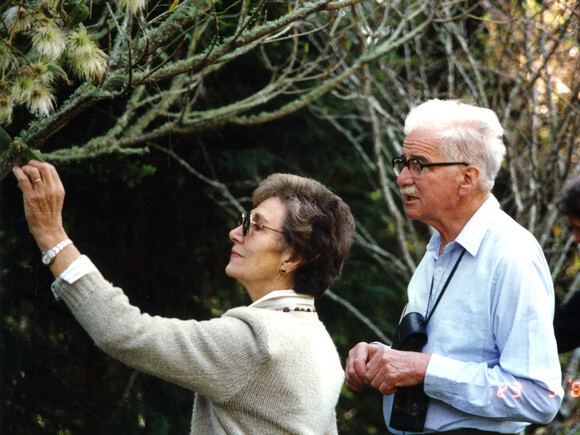
So often consigned to dark, shady areas, where they grow but will never give of their best, as they really do need the opposite, maximum light and exposure in order to colour well in the winter and we find they grow best in open areas on our poorer, drier soils where they form an essential feature of our drought resistant Gravel Garden. They really are the hosta of the dry garden, giving us the large bold leaf so desperately needed for contrast with plants such as thin-leaved grasses, lacy silver foliage plants or spiky plants. All adapted to survive dry conditions to which the leathery elephant’s ears are a perfect foil.
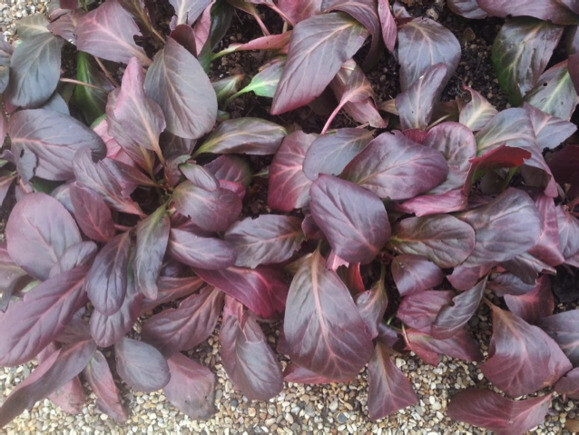
Bergenia ‘Beethoven’ in winter garb
Winter foliage colour
And it is during the winter months that bergenias come into their own but be patient as it’s not until the colder weather arrives that those wonderful mahogany, plum and coral red hues truly appear. It is essential to choose those cultivars that have leaves which colour well, as many do not. Cultivars of note with the most intense winter foliage colour are Bergenia 'Abendglocken' (our favourite), others of note are B. 'Admiral', B. 'Eric Smith' and B. 'Bressingham Ruby'.
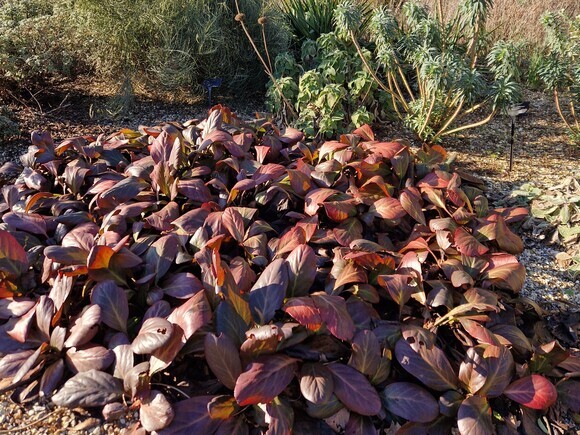
Smaller, more compact cultivars with good winter colour include the pink flowered Bergenia 'Wintermarchen' and B. 'Mrs Crawford', a superb white flowering cultivar with deep plum-red winter foliage and the only white-flowering cultivar that does not fade to pink. Another, Bergenia 'Beethoven' is probably the best of the paler flowering forms with good winter foliage colour and flowers that only fade faintly to pale pink as they age.
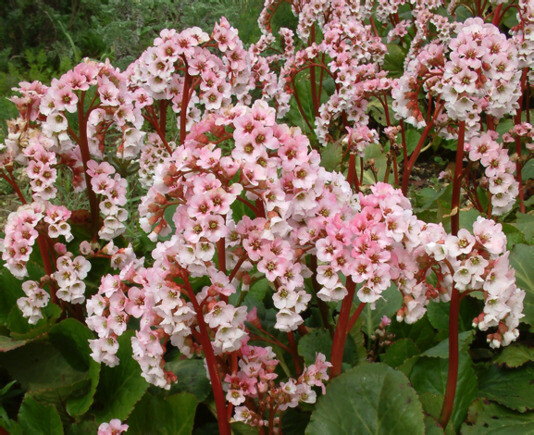
Spring Flowers
As if the winter foliage is not enough a reason to look favourably on the genus and as fresh foliage emerges with a greener hue during spring, along come the flowers, the open sunny sites encouraging a profusion of showy clusters of bell-like flowers during April. All shades of white and pink are catered for. Popular with visitors is Bergenia 'Schneekönigin' with tall clusters of pale shell-pink, alas the foliage stays green all winter. In fact, Summer sees all bergenias turn green, their thick leathery leaves, unperturbed during dry spells and proving the perfect foil for other, more colourful performers.
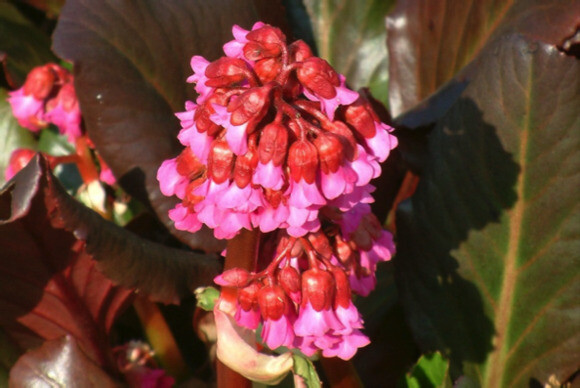
Bergenia ‘Abendglut’ with the foliage still showing some winter colour
Dealing with problems
Problems; slugs and snails are certainly an issue although regular tiding up of old decaying leaves will help prevent this. Vine weevil; belonging to the saxifrage family, bergenias along with those other vine weevil favourites, heuchera, are prone to both adult vine weevils damaging the foliage and their grubs eating the roots. Again regular tidying up of old foliage and growing in an open, sunny site will help limit the damage. For those with bad infestations, regular treatment with nematodes, Steinernema Kraussei during spring and again in autumn can prove to be effective.
Overall they are an invaluable genus that we would find impossible to replace and are an essential and indispensable ingredient of our famous drought-resistant Gravel Garden.
I wonder if someone will comment expressing the opposite view, as Beth did to Christo. I somehow expect (and hope) they will!


We inherited a pink variety - don’t know which but I find I have to ‘ keep it under control’ which upsets the other half! It certainly brightens up late winter when it flowers in our Isle of Wight garden.
The hens are so delighted by the leaves they soon have nothing but the mid ribs left. Not a pretty sight.
Sadly I am unable to visit the gardens, but take every opportunity to make the most of internet and library information. My garden has grown progressively more arid over the last fifty years, and the bergenias are still thriving in a hen free environment.
I am looking forward to visiting the gardens for the first time later this year and know I will come away with lots of inspiration!
I remember visiting Chelsea a long time past and was inspired by the wonderful combinations of plants on your stand. Thank you Beth Chatto.